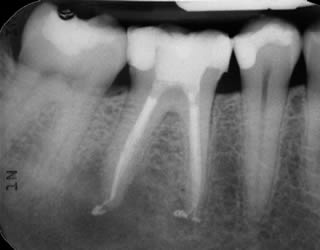Root Canal Procedure Or Tooth Extraction?

When the root canals of a tooth become infected, there are usually two treatment options available.
Root canal procedures are something that most patients dread, however there is no need for this fear as we will see later. It has, though, unfortunately gained a reputation for being a benchmark for the worst pain possible.
While we say that there are only two options available, some people may be tempted to ignore the problem altogether, hoping it will go away. It is usually these patients who call us soon afterwards in a high degree of pain, desperate for an emergency appointment. While we do the best that we can, it may be a few hours before you are seen, and this can be quite painful wait unfortunately. Consequently it makes sense to address any issues early if you suspect there is a problem.
In this blog then, we are going to take a look at the options of root canal treatment and an extraction. First of all, let us take a look at some of the implications for our Chelmsford patients if an extraction is chosen.
Extractions
Extractions were probably one of the very first dental procedures ever carried out. Back in time, where next to no knowledge was available about our teeth, it probably made sense to pull out a tooth that was painful. Some of you may also have had teeth out when you were younger, either through decay caused by eating too many sweets and not brushing your teeth, or perhaps due to the mouth being overcrowded. There are legitimate reasons for extracting a tooth, but given the knowledge now available, it is usually used as a last resort.
If you have a root canal infection and refuse to have root canal treatment and choose to have the tooth extracted, what can patients of Cygnet Dental expect?
We will presume, for the sake of this blog that you already know enough about having a tooth out, but do you know enough about the consequences of this? An extracted tooth may not cause you any problems immediately, but the consequences of losing that tooth continue long after it has gone.
The first issue is that when a tooth goes, so does some of the bone in the jaw in that area. This can cause small changes to the shape of your face and may also, in some cases, give you a more ‘drawn’ and older appearance. The loss of bone and the fact that a gap now exists where the tooth once was also means that it leaves a space for the adjacent teeth to move into. As these teeth start to encroach into the space, they also leave small spaces and other teeth also move. Eventually, just the loss of a single tooth could cause you to have a crooked smile. If you do have a tooth extracted, a dental implant offers the best replacement as this provides an artificial tooth root which helps to protect the bone structure as well as providing a strong and secure tooth replacement.
Root canal procedure
In most situations, we will recommend that you have root canal therapy in the event that you have a root canal infection. With this treatment, there is every chance that the tooth can be saved in a way which gives it a good degree of functionality. The treated tooth will provide a good level of strength but care needs to be taken when you eat hard foods.
For most people, the main barrier is undergoing the procedure that they have heard so much about, nearly always in a highly negative manner. Please allow us to set the record straight.
First of all, a root canal procedure is an invasive one and it is likely that some level of discomfort might be felt, as you would expect from most invasive procedures. What is not true though is that it is extremely painful. The procedure is carried out using a strong local anaesthetic and although you might feel some sensations during the treatment, you should not feel any great degree of pain. It is more than likely that its reputation came before x-rays were used. This would mean that there was no way of knowing if an abscess was present. Drilling into one of these would be excruciatingly painful indeed. The good news is that x-rays are now routinely taken before root canal procedures and any abscesses treated before the treatment takes place.
The procedure itself may take longer than some that you are more familiar with such as a filling. Don’t worry though, we will make sure that the level of local anaesthetic stays sufficient for you to have the treatment in relative comfort.
Once the treatment has been carried out, you will be able to use the tooth once the local anaesthetic has worn off. One thing to be aware of is that, during the procedure, the nerves in your tooth will have been removed. This means that it can become hard to judge how hard you are biting down. This can cause problems for the tooth and care should be taken when eating.
While we are happy to discuss all options available in this situation, we do advise our Chelmsford patients that they should ignore any rumours that they have heard about this particular treatment and speak directly to us. We can give you all the information that you need so that an informed decision can be taken.
If you would like any more information about the topics in this blog, any other treatment or if you would like to make an appointment, please call the Cygnet Dental Practice in Wickford on 01268 733078.
